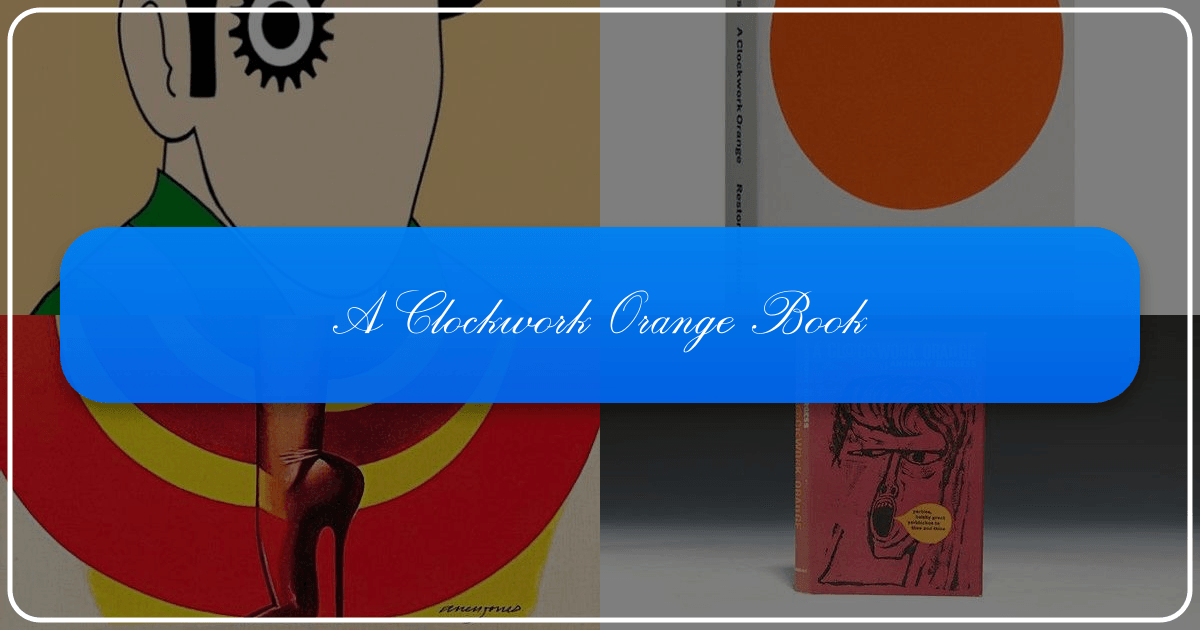A Clockwork Orange: An In-Depth Exploration of Anthony Burgess's Dystopian Masterpiece

Anthony Burgess’s A Clockwork Orange, published in 1962, remains a chillingly relevant exploration of free will, societal control, and the complexities of human nature. This dystopian masterpiece, characterized by its inventive slang and unflinching depiction of violence, has cemented its place as a literary landmark, influencing countless works and sparking ongoing debate about its themes and interpretations. This essay will delve into various aspects of A Clockwork Orange, examining its plot, characters, linguistic innovations, cultural impact, and critical reception, drawing upon information from reputable sources such as Lbibinders.org, Wikipedia, and other scholarly articles.
Plot Summary: A Descent into Ultra-Violence and Redemption
The novel unfolds in three distinct parts, each composed of seven chapters—a deliberate choice by Burgess, reflecting the symbolic significance of the number 21 in the context of human maturation (Wikipedia). The story follows Alex, a teenage sociopath, and his gang of “droogs” as they engage in a spree of ultra-violence—a term coined by Burgess himself, signifying extreme and gratuitous violence (Wikipedia). Their nightly escapades involve random acts of brutality, culminating in a horrific home invasion and rape. Alex’s enjoyment of classical music, particularly Beethoven, stands in stark contrast to his depravity, highlighting the duality of his personality. This duality forms a central theme throughout the narrative.

Alex’s violent actions lead to his arrest and imprisonment. In an attempt to rehabilitate him, the state subjects Alex to the Ludovico Technique, a form of aversion therapy that conditions him against violence. While successful in suppressing his violent impulses, the technique also strips him of his free will and robs him of the pleasure he derived from his beloved classical music, a pivotal loss that adds another layer to his suffering.
Upon his release, Alex faces a hostile world. He is abandoned by his former droogs, who have now become police officers, and is brutally attacked by the man he had previously assaulted. He finds refuge with the writer whose home he had invaded, only to be further victimized when the writer and his associates attempt to use Alex’s plight to undermine the government. Alex attempts suicide but ultimately survives, and, to the government’s relief, his conditioning appears to have reversed, his violent tendencies returning.
The novel’s controversial final chapter, omitted from early US editions (Wikipedia), depicts Alex’s transition towards maturity and a rejection of his violent past. He finds growing disillusionment with ultra-violence, indicating a potential path toward societal integration and family life. This ending, however, is not without its complexities, leaving readers to ponder the true possibility of lasting change and whether the cycle of violence might repeat itself in the next generation.

Characters: A Cast of Dystopian Archetypes
The characters in A Clockwork Orange are complex and multi-faceted, often serving as allegorical representations of broader social and political forces.
-
Alex: The central character, a charismatic yet ruthless leader, functions as both protagonist and anti-hero. His journey explores the limits of societal control and the enduring nature of human desires. His use of Nadsat language serves to both distance and engage the reader, creating a uniquely unsettling narrative voice.
-
The Droogs: Alex’s accomplices, Dim, Georgie, and Pete, embody different aspects of teenage rebellion and delinquency. Their dynamic reflects the shifting power structures within the gang and the challenges of maintaining control. Pete’s eventual reformation provides a counterpoint to Alex’s violent path, suggesting the possibility of redemption.
-
The State Authorities: Figures like the prison chaplain, the Minister of the Interior, and the doctors involved in the Ludovico Technique represent the state’s attempts to control and manipulate individual behaviour. Their actions raise crucial ethical questions regarding the balance between public safety and individual freedom.
-
F. Alexander: This writer, a victim of Alex’s violence, becomes a symbol of the intellectual resistance to the state’s methods. His actions mirror Alex’s earlier violence, showing the potential for victimhood to engender its own form of cruelty.
These characters, along with other minor figures like Billyboy and Cat Woman, contribute to a rich tapestry of personalities, each adding layers to the novel’s complex thematic structure.
The Use of Nadsat: A Linguistic Innovation
Burgess’s creation of Nadsat, the distinctive slang spoken by Alex and his droogs, is a remarkable feat of linguistic invention (Wikipedia). This argot, a blend of Slavic words, Cockney rhyming slang, and other influences, serves multiple purposes:

-
Immersion: It draws the reader into Alex’s world, providing an immediacy and visceral quality to the narrative.
-
Distancing: The inherent difficulty in understanding Nadsat acts as a shield, softening the impact of the violent content, thereby making the novel less explicitly pornographic, according to Burgess’s own statements (Wikipedia).
-
Social Commentary: Nadsat reflects the alienated and rebellious nature of youth culture, creating a sense of linguistic and societal disruption.
The inclusion of a glossary in later editions allows a broader readership to access the story, but the deliberate obscuring of language in the original underscores the novel’s underlying themes of alienation and social control. This creative use of language contributes significantly to the book’s lasting impact and its unique place in literary history.
Cultural Impact: From Literary Influence to Film Adaptation
A Clockwork Orange’s impact extends far beyond the realm of literature. Its themes and stylistic elements have resonated across various media and cultural spheres.
The most famous adaptation of the novel is Stanley Kubrick’s 1971 film (Lbibinders.org, Wikipedia). While highly influential and visually stunning, Kubrick’s film omits the final chapter, altering the narrative’s focus and impacting the interpretation of Alex’s eventual moral development. Burgess himself expressed dissatisfaction with Kubrick’s interpretation, deeming it a “badly flawed” representation of his work (Wikipedia).
Beyond the film, A Clockwork Orange has inspired numerous theatrical adaptations, manga, and other works, demonstrating its enduring influence across artistic media. The novel has also sparked significant debate on the role of violence and censorship in society, and its exploration of free will continues to be a subject of academic discussion. The book’s presence on multiple “best-of” lists, including Time magazine’s selection of the 100 best English-language novels since 1923, further underscores its sustained importance in the literary canon (Wikipedia).
Reception and Critical Appraisal: A Controversial Legacy
A Clockwork Orange received mixed reviews upon its publication. While some critics praised the novel’s innovative language and social commentary, others expressed discomfort with its graphic depiction of violence and its challenging exploration of moral ambiguity (Wikipedia). The use of Nadsat, while initially praised for its originality, also contributed to the controversy, with some readers finding it too difficult to penetrate.
Even Burgess himself had a complicated relationship with his own creation. He later expressed reservations about the novel’s didactic nature and the potential for misinterpretation, particularly in relation to its film adaptation (Wikipedia). This complexity of reception highlights the novel’s lasting power to provoke and challenge, encouraging ongoing dialogue and interpretation.
Conclusion: A Clockwork Orange’s Enduring Relevance
A Clockwork Orange stands as a literary testament to Anthony Burgess’s creative genius and visionary storytelling. Its unflinching portrayal of violence, innovative use of language, and exploration of complex moral dilemmas continue to resonate with readers and critics alike. While the novel’s themes and interpretations remain a subject of debate, its enduring impact on literature, film, and cultural discourse is undeniable. Its exploration of free will versus determinism, the role of state control, and the complexities of human nature ensures its place as a significant work of the 20th and 21st centuries. The continued discussion surrounding its themes, along with its enduring popularity, serve as a testament to its profound and lasting influence. Further research, accessible through resources like Lbibinders.org and other academic databases, can enrich our understanding of this complex and compelling literary masterpiece.